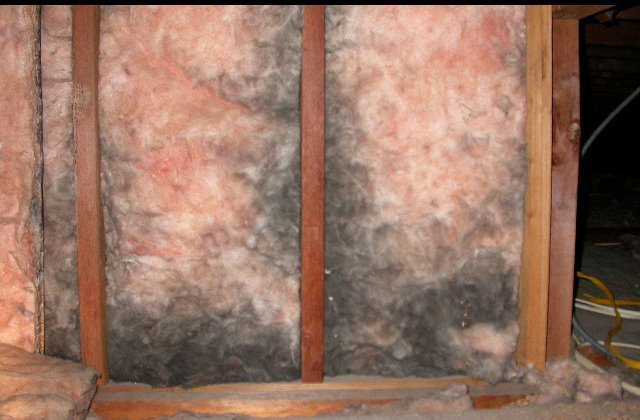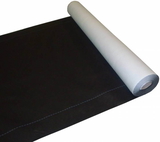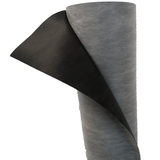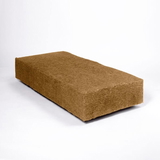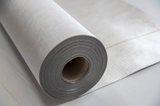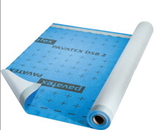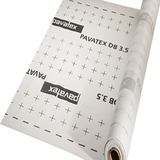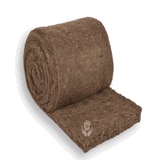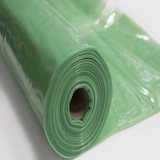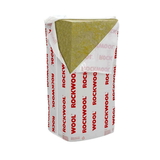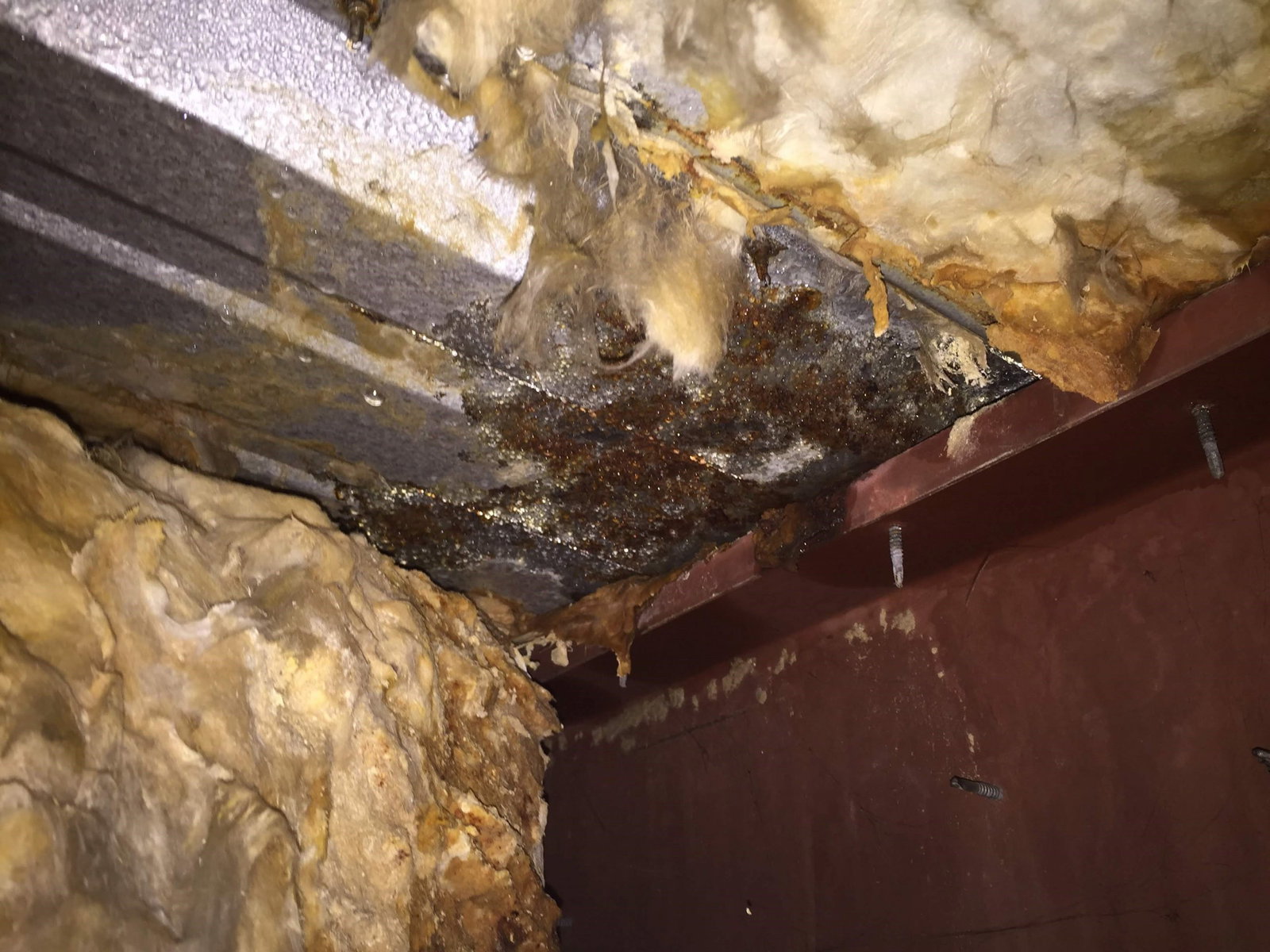- Blogs
- What to do when insulation gets wet?
What to do when insulation gets wet?

We get a lot of people asking us what to do when insulation gets wet. It's usually to do with wet loft insulation but there are other areas in your home where the insulation can get damaged by moisture ingress.
In this blog, we will explore why insulation materials, should be kept away from water, how water impacts the insulating properties of the products, what you should do when insulation gets wet and much more.
What causes insulation to get wet?
There are several reasons why insulation may become wet. Some of the most common causes include:
- Leaky roofs or gutters: If your roof or gutters are in poor condition, they may allow water to enter your home and come into contact with your insulation. This can cause the insulation to become wet and lose its effectiveness.
- Plumbing leaks: If you have any plumbing pipes or appliances that run through your insulation, a leak in these pipes or appliances can cause the insulation to become wet.
- High humidity: If the air in your home is very humid, it can cause moisture to collect on your insulation and make it wet.
- Flooding: If your home experiences a flood, the water can get into your insulation and cause it to become wet.
- Poor ventilation: Insufficient ventilation in your attic or crawl space can cause moisture to become trapped in your insulation, leading to wet insulation.
![insulation gets wet]() How does high humidity cause water damage to insulation?
How does high humidity cause water damage to insulation?
The daily, basic activities we do, like showering, cooking and others generate a lot of steam and water vapour, which could get trapped within the building without proper ventilation. In addition, the building's insulation may not be breathable and could prevent the humidity from escaping via vents and cracks in the external building fabric
When this happens, the moisture gets trapped in and around the insulation itself. If this moisture condenses it can be a breeding ground for mould.
In fact, it's pretty simple. Warm air contains moisture. This moisture must go somewhere, right? So, when there is no outlet, it reaches its dew point and condenses, either on the insulation or the building material.
So, you must have proper ventilation along with adequate insulation.
Wet insulation: what are the effects?
1. R-value:
Insulation has an R-value, which is an indicator of how effective it is to keep heat in a building. The higher the R-value, the better the insulation is at insulating the building. Insulation works better when its R-value is higher.
When insulation becomes wet, its thermal performance (R-value) will decrease as the water causes the air trapped within it to be displaced. This causes the insulation to become inefficient. It may cause you to pay more for heating and cooling equipment.
Instead of being an insulator, it has now become a conductor of heat. I.e - It transmits heat instead of blocking it. Now it is ineffective when it comes to insulating your home and in fact is worse than having no insulation at all!
Energy bills could rise, the polar opposite of what good insulation is supposed to do.
2. Mould growth and air quality:
Mould can cause serious health problems for people living in damp or damp areas. Mould thrive in moist and dark areas, and it can be difficult to get rid of it.
Mould can cause serious problems for people who live near it, including asthma attacks and coughing.
Insulation is installed in areas that are too small for moisture to escape. This means that if moisture gets trapped in that area, in a cavity wall, for example, mould can start to grow and thrive on the wet insulation in the cavity.
Eventually, it will show itself through the wall as black spots. This is any homeowner's nightmare especially if you have vulnerable people living with you like elderly relatives or young children.
3. Wet walls lead to overall structural damage:
You may not know if your insulation is wet or not, as it is rarely visible, typically found in wall cavities or underneath the floor/roof.
Bubbling wallpaper, visible brown-coloured watermarks on the wall and peeling paints are often the first signs of wet insulation. When left to its own devices, moisture can cause structural damage in the longer run.
Signs you may have water-damaged insulation
Because insulation is usually hidden by walls, floors or ceilings, you may not even notice that it is wet or moist until it starts causing damage to your building.
However, if you notice any of the signs below, it is important that you call an expert to confirm your suspicions.
Signs that you should be looking out for are:
- Smell of damp
- Mould growing
- Stains
- Peeling wallpaper
- Paint flaking off
If you suspect your insulation is wet within closed wall cavities, you can try and detect elevated levels of moisture using a moisture meter.
However, ultimately you will have to open the wall cavity to see if it is wet and allow the insulation and other related materials to dry.
How different insulation materials react to moisture
Not all insulation materials react the same way to moisture. In fact, you can buy more moisture-resistant insulation to use as wet area insulators such as around bathrooms. Read on to see the differences.
Can Fibreglass Insulation Get Wet?![Wet insulation]()
Even though fibreglass insulation is resistant and is generally unaffected by moisture in small amounts, a burst pipe or leaking roof can still make the insulation soggy. When this happens, the water displaces the air spaces between the thin fibres, affecting its insulating ability.
Proper ventilation in the area where fibreglass insulation is being laid or using vapour barriers can prevent moisture build-up within the insulation.
Regular checks on areas with visible insulation, like inside the loft, can help catch the issue early.
If the fibreglass insulation is found wet, remove the affected area and place it in a warm place to dry out naturally with lots of ventilation. Once dried, you can install the fibreglass insulation back in place. If this is not possible you will have to throw the insulation away and replace it.
Check the insulation again in a few days and replace it if the smell or moisture persists.
Need New Fibreglass Insulation?
Can rockwool insulation get wet?
While rockwool is not specifically designed to be moisture-resistant, it can still perform well in damp environments. This is because it is made from stone or slag, which are naturally water-resistant materials.
In addition, rockwool is often treated with a water-repellent coating or adhesive to help it resist moisture.
Rock wool insulation also allows vapour to pass through. This moisture-resistant insulation does not wick water and since it is not made of any organic material, it does not promote mould growth.
However, when there are leaks around the insulation, it will still get wet. It will also regain its previous performance once it fully dries out.
Need New Rock Wool Insulation?
Is PIR insulation waterproof?
PIR insulation, or polyisocyanurate insulation, is not waterproof. However, it is resistant to moisture. This means that it can perform well in damp environments and will not be damaged by water or moisture in small and infrequent amounts.
That being said, if PIR insulation is exposed to excessive amounts of water or moisture for an extended period of time, it may begin to break down and lose its insulating properties.
It is made of closed-cell foam, which means that it is composed of tiny cells that are filled with gas.
However, because the cells are not totally watertight, PIR insulation is not waterproof.
The foil facings on both sides of the PIR Insulation board further protect the insulation from getting wet.
Do not use any sort of heating source or naked flames to dry out the insulation as it does not react well to fire.
Wood fibre / Cellulose loose fill insulation
Some materials are highly susceptible to moisture saturation and warping, such as wood fibre and cellulose insulation. Both could threaten the integrity of nearby structures if they are left to sit, causing rotting timbers amongst other things.
Can Wet Insulation Dry Out?
Yes, you can dry out wet insulation. The amount of time it takes for wet insulation to dry out will depend on a number of factors, including the type of insulation, the ventilation in the area where the insulation is located, and the ambient temperature and humidity.
In general, it is best to remove wet insulation and replace it with new insulation to ensure that it is effective in insulating your home.
If you are unable to replace the insulation immediately, then take the following steps -
- First, remove any standing water from the area where the insulation is located. This can be done using a wet/dry vacuum, mop, or other suitable tools.
- Next, use fans and dehumidifiers to help dry out the area. This will help to remove moisture from the air, which will help the insulation to dry out more quickly.
- Use a fan heater to blow warm air over the insulation to help speed up the drying process in addition to the above steps.
- Once the insulation has dried out, check it carefully for signs of damage or deterioration. If the insulation is damaged or has lost its effectiveness, it should be removed and replaced with new insulation.
What happens if loft insulation gets wet?
If you have a cold loft space that is used for storage, chances are that when the heated air gets into this space through light fittings and just small cracks in the walls and ceilings, it condenses on the underside of felt, tiles, or any other cold surface inside the attic.
Eventually, this will result in condensation dripping on the attic insulation itself.
Another possible cause if your loft insulation is wet, could be a roof leak. This can happen if a roof tile slips or flashing around your chimney comes loose for example. It may not be a torrent of water but It could drip all over the insulation causing wet patches.
Either replace the insulation or dry it out as discussed in the previous section.

Risks of wet cavity wall insulation
We talked in detail about the problems with cavity wall insulation here. However, here's a quick recap.
Wet cavity wall insulation can be caused by a number of factors, including water infiltration through the outer wall, condensation within the cavity, and inadequate ventilation within the wall itself.
Moisture can enter the cavities when the external walls are soaked by driving rain, poor brickwork, and pointing, or leaking gutters.
In some cases, wet cavity wall insulation can be caused by a lack of proper drainage around the foundation of the building, which can cause water to build up and enter the cavity through the bottom of the wall.
To prevent wet cavity wall insulation, there are a few steps you can take:
- Make sure the cavity is properly sealed and ventilated. This will help to prevent water from entering the cavity from the outside, as well as prevent condensation from forming within the cavity.
- Address any potential sources of water infiltration. This could include repairing damaged or cracked mortar, sealing gaps around windows and doors, and ensuring that gutters and downspouts are in good working order and directing water away from the building.
- Install proper drainage around the foundation of the building. This will help to prevent water from collecting around the base of the wall and entering the cavity through the bottom of the wall.
- Use water-resistant materials in the construction of the outer wall. This could include using water-resistant brick, stone, or stucco on the exterior of the wall, or applying a waterproof coating to the wall.
You can trace these issues with the help of a professional and remedy them according to their suggestions.
How to prevent wet insulation?
Prevention is definitely better than a cure in the case of wet insulation.
There are a few steps you can take to prevent wet insulation:
- Make sure that your roof and gutters are in good condition and are not leaking. This will prevent water from entering your home and getting into your insulation.
- If you have any plumbing pipes or appliances that run through your insulation, make sure they are properly sealed and well-maintained to prevent leaks.
- If you have a crawl space or attic, make sure they are properly ventilated to prevent moisture from getting trapped in your insulation.
- If your insulation has become wet, remove it as soon as possible and replace it with new insulation. Wet insulation can lose its effectiveness and can pose health risks.
- Consider using a vapour barrier between your insulation and other cold surfaces to prevent moisture from getting into your insulation in the first place. This can be especially effective in areas that are prone to high humidity or moisture.
Taking these simple steps can help ensure that your insulation remains dry and efficient for years to come.
How to prevent moisture from building up inside your home?
Considering that condensation can be one of the major causes of wet insulation, we should consider how to address high levels of humidity in order to prevent your insulation from being damaged by water.
There are several steps you can take to prevent moisture from building up inside your home:
- Keep your home well-ventilated: Proper ventilation is crucial in preventing moisture build-up. Make sure to open windows and doors frequently, especially in areas where moisture is most likely to accumulate, such as bathrooms and kitchens. Open windows when you have hot showers, to allow the visible steam to escape.
- Use exhaust fans: Exhaust fans in bathrooms and kitchens can help remove excess moisture from the air, reducing the risk of condensation and mould growth.
- Use a dehumidifier: A dehumidifier can help control the level of moisture in the air, preventing it from reaching levels that can lead to condensation and mould growth.
- Install MVHR system or similar. A MVHR (Mechanical Ventilation with Heat Recovery) system is designed to remove moisture from the air in a home. It does this by using a series of fans and ducts to draw air from inside the home and pass it through a heat exchanger. As the air passes through the heat exchanger, the moisture in the air condenses and is collected in a drain. This helps to maintain a healthy, moisture-free environment inside the home.
- Fix any leaks: Leaks in plumbing or the roof can cause water to seep into your insulation. Be sure to fix any leaks as soon as they are discovered to prevent further moisture damage.
- Dry wet areas immediately: If any part of your home becomes wet, like shower room floors, be sure to dry it out as quickly as possible. This will help prevent mould growth and other moisture-related problems.
- Install moisture-resistant insulation: Using moisture-resistant insulation in areas like the attic and basement can help prevent moisture from accumulating in these areas, protecting your home from mould and other moisture-related issues. Materials like Multifoils, Rockwool insulation, or closed cell phenolic can help you from dealing with wet insulation.
FAQ'S
Is wet insulation dangerous?
Wet insulation can be a dangerous hazard in your home or building. It can lead to the growth of mold and mildew, which can cause respiratory issues for occupants of the building as well as damage to the structure itself.
In some cases, wet insulation can even pose a fire hazard if it is in contact with electrical wiring or other combustible materials.
If any of your insulation is damaged when it becomes wet from a flood or a sewage backup, the affected insulation and the wallboard are likely to be ruined, and both materials need to be removed as soon as is practical.
Flood water contains toxins that can be absorbed by the insulation and wallboard, and these toxins could persist even after the water evaporated.
How to dispose of wet insulation?![wet fibreglass insualtion]()
When disposing of wet insulation, it is important to take the proper safety precautions. Make sure to wear protective clothing such as gloves, a face mask, and long sleeved and covered clothing.
Start by turning off all electricity in the area you are working in. Then use a shovel to remove the wet insulation and place it in a sealed garbage bag. If you have large amounts of insulation, you can rent a vacuum cleaner with a specialized filter designed for this type of project.
After your rubbish bag is full, make sure to securely tie it up and dispose of it properly at your local landfill or hazardous waste center. Taking these steps will help keep you safe while properly disposing of wet insulation.
Can insulation be “waterproofed”?
Insulation is not typically waterproofed because it is designed to be installed in areas that are not exposed to water.
However, some types of insulation, such as closed-cell insulation like Nitrile Rubber, are naturally resistant to water and can be used in areas where there is a potential for moisture.
In general, it is important to ensure that the area where insulation is being installed is properly sealed and protected from water to prevent damage and ensure that the insulation is effective.
Can Insulation Get Wet?
Yes, all insulation can get wet, but it all depends on the material and how you tackle the issue.
Does insulation go bad if it gets wet?
Yes but some more so than others. For example, cellulose insulation is rendered completely ineffective and a health risk liability.
But in the case of closed cell insulation such as phenolic and PIR with aluminium foil facings, then this type of insulation can withstand some exposure to moisture as long as it is short-lived and the insulation is given a chance to dry out afterwards
Rock wool vs Fibreglass, which is more water resistant?
In terms of water resistance, rock wool is usually the better choice. It has a natural waterproofing property due to its mineral composition, which helps keep moisture out of the insulation material.
Fibreglass, on the other hand, can absorb water and lose some of its insulating properties when it does so.
To help prevent this, special coatings can be applied to fibreglass for added protection against water damage during the manufacturing process, such is the case with Dritherm 32 and Dritherm 37.
Overall, rock wool is more water resistant than fibreglass and tends to provide better insulation in wet climates or environments where humidity levels are high.
In conclusion:
The use of moisture-resistant insulation along with proper ventilation helps win the battle against dampness and makes your home condensation free. In addition, check your insulation regularly and keep an eye out for pipe bursts or leaks that could water damage your insulation.
If you are looking for moisture-resistant insulation for ducts, pipes, walls, or lofts, or if you want to replace your existing loft or walls insulation, we at Buy Insulation Online can help you.
Protect 5 existing trees and plant a new one for free with every order you place with us. This will offset your carbon too associated with this order making it carbon neutral.

Samuel Hitch
Managing Director
Buy Insulation Online.
Leave A Reply
Your feedback is greatly appreciated, please comment on our content below. Your email address will not be published. Required fields are marked *












